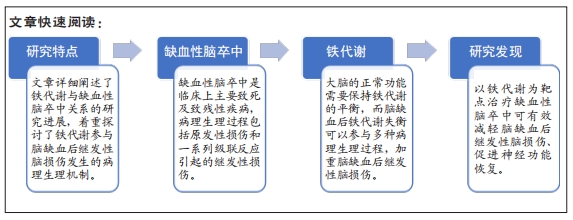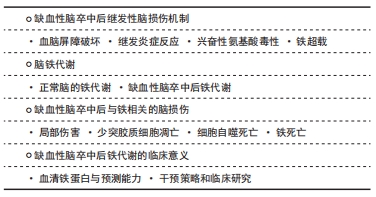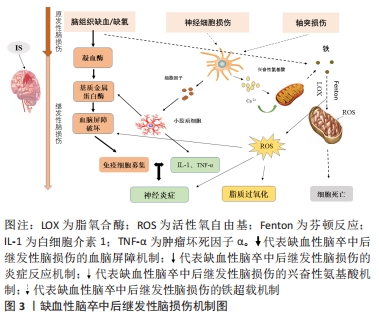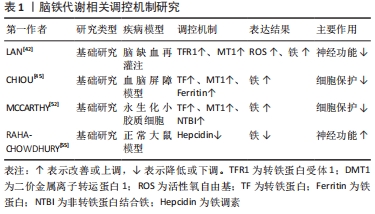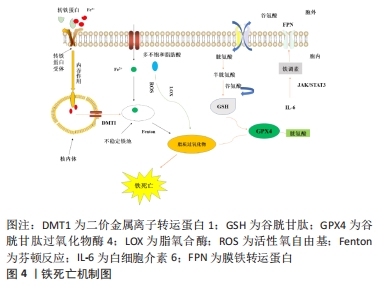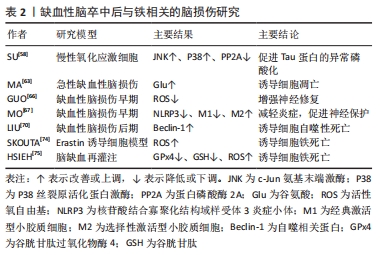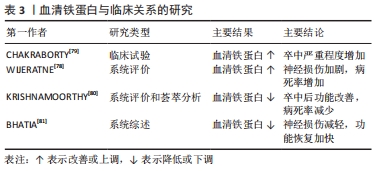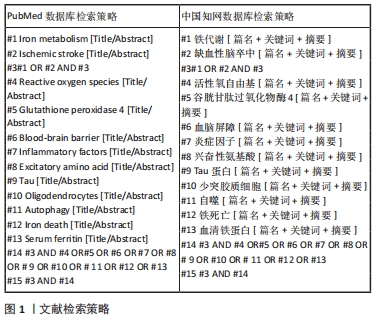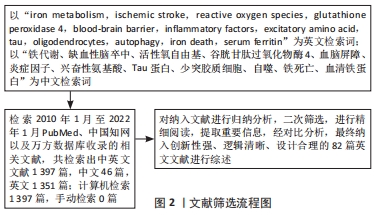[1] KIM SH, CHUNG DK, LEE YJ, et al. Neuroprotective effects of Danggui-Jakyak-San on rat stroke model through antioxidant/antiapoptotic pathway. J Ethnopharmacol. 2016;188:123-133.
[2] HERPICH F, RINCON F. Management of Acute Ischemic Stroke. Crit Care Med. 2020;48(11):1654-1663.
[3] GE JJ, XING YQ, CHEN HX, et al. Analysis of young ischemic stroke patients in northeast China. Ann Transl Med. 2020;8(1):3.
[4] BARTHELS D, DAS H. Current advances in ischemic stroke research and therapies. Biochim Biophys Acta Mol Basis Dis. 2020;1866(4):165260.
[5] BENJAMIN EJ, BLAHA MJ, CHIUVE SE, et al. Heart Disease and Stroke Statistics- 2017 Update: A Report From the American Heart Association. Circulation. 2017; 135(10):e146-e603.
[6] KHANDELWAL P, YAVAGAL DR, SACCO RL. Acute Ischemic Stroke Intervention. J Am Coll Cardiol. 2016;67(22):2631-2644.
[7] YANG C, HAWKINS KE, DORé S, et al. Neuroinflammatory mechanisms of blood-brain barrier damage in ischemic stroke. Am J Physiol Cell Physiol. 2019;316(2): C135-C153.
[8] MAGTANONG L, DIXON SJ. Ferroptosis and Brain Injury. Dev Neurosci. 2018; 40(5-6):382-395.
[9] KIM JY, PARK J, CHANG JY, et al. Inflammation after Ischemic Stroke: The Role of Leukocytes and Glial Cells. Exp Neurobiol. 2016;25(5):241-251.
[10] HERTELENDYP, TOLDI J, FüLöP F, et al. Ischemic Stroke and Kynurenines: Medicinal Chemistry Aspects. Curr Med Chem. 2018;25(42):5945-5957.
[11] GUAN X, LI X, YANG X, et al. The neuroprotective effects of carvacrol on ischemia/reperfusion-induced hippocampal neuronal impairment by ferroptosis mitigation. Life Sci. 2019;235:116795.
[12] RADAK D, KATSIKI N, RESANOVIC I, et al. Apoptosis and Acute Brain Ischemia in Ischemic Stroke. Curr Vasc Pharmacol. 2017;15(2):115-122.
[13] ASHRAF A, CLARK M, SO PW. The Aging of Iron Man. Front Aging Neurosci. 2018; 10:65.
[14] DATTA A, SARMAH D, MOUNICA L, et al. Cell Death Pathways in Ischemic Stroke and Targeted Pharmacotherapy. Transl Stroke Res. 2020;11(6):1185-1202.
[15] PARK UJ, LEE YA, WON SM, et al. Blood-derived iron mediates free radical production and neuronal death in the hippocampal CA1 area following transient forebrain ischemia in rat. Acta Neuropathol. 2011;121(4):459-473.
[16] VALDÉS HERNÁNDEZ MDC, CASE T, CHAPPELL FM, et al. Association between Striatal Brain Iron Deposition, Microbleeds and Cognition 1 Year After a Minor Ischaemic Stroke. Int J Mol Sci. 2019;20(6):1293.
[17] SELIM M, FOSTER LD, MOY CS, et al. Deferoxamine mesylate in patients with intracerebral haemorrhage (i-DEF): a multicentre, randomised, placebo-controlled, double-blind phase 2 trial. Lancet Neurol. 2019;18(5):428-438.
[18] NIAN K, HARDING IC, HERMAN IM, et al. Blood-Brain Barrier Damage in Ischemic Stroke and Its Regulation by Endothelial Mechanotransduction. Front Physiol. 2020;11:605398.
[19] SWEENEY MD, ZHAO Z, MONTAGNE A, et al. Blood-Brain Barrier: From Physiology to Disease and Back. Physiol Rev. 2019;99(1):21-78.
[20] RONALDSON PT, DAVIS TP. Regulation of blood-brain barrier integrity by microglia in health and disease: A therapeutic opportunity. J Cereb Blood Flow Metab. 2020;40(1_suppl):S6-S24.
[21] GURUSWAMY R, ELALI A. Complex Roles of Microglial Cells in Ischemic Stroke Pathobiology: New Insights and Future Directions. Int J Mol Sci. 2017;18(3):496.
[22] ABDULLAHI W, TRIPATHI D, RONALDSON PT. Blood-brain barrier dysfunction in ischemic stroke: targeting tight junctions and transporters for vascular protection. Am J Physiol Cell Physiol. 2018;315(3):C343-C356.
[23] VARATHARAJ A, GALEA I. The blood-brain barrier in systemic inflammation. Brain Behav Immun. 2017;60:1-12.
[24] FADEN AI, WU J, STOICA BA, et al. Progressive inflammation-mediated neurodegeneration after traumatic brain or spinal cord injury. Br J Pharmacol. 2016;173(4):681-691.
[25] ABBOTT NJ, PIZZO ME, PRESTON JE, et al. The role of brain barriers in fluid movement in the CNS: is there a ‘glymphatic’system. Acta Neuropathol. 2018; 135(3):387-407.
[26] JOLIVEL V, BICKER F, BINAMÉ F, et al. Perivascular microglia promote blood vessel disintegration in the ischemic penumbra. Acta Neuropathol. 2015;129(2):279-295.
[27] LAN X, HAN X, LI Q, et al. Modulators of microglial activation and polarization after intracerebral haemorrhage. Nat Rev Neurol. 2017;13(7):420-433.
[28] AHMAD M, DAR NJ, BHAT ZS, et al. Inflammation in ischemic stroke: mechanisms, consequences and possible drug targets. CNS Neurol Disord Drug Targets. 2014; 13(8):1378-1396.
[29] VALLON M, CHANG J, ZHANG H, et al. Developmental and pathological angiogenesis in the central nervous system. Cell Mol Life Sci. 2014;71(18):3489-3506.
[30] ARCHIBALD J, MACMILLAN EL, ENZLER A, et al. Excitatory and inhibitory responses in the brain to experimental pain: A systematic review of MR spectroscopy studies. Neuroimage. 2020;215:116794.
[31] MERELLI A, REPETTO M, LAZAROWSKI A, et al. Hypoxia, Oxidative Stress, and Inflammation: Three Faces of Neurodegenerative Diseases. J Alzheimers Dis. 2021;82(s1):S109-S126.
[32] LIU Y, WANG S, KAN J, et al. Chinese Herbal Medicine Interventions in Neurological Disorder Therapeutics by Regulating Glutamate Signaling. Curr Neuropharmacol. 2020;18(4):260-276.
[33] ZENDEDEL E, BUTLER AE, ATKIN SL, et al. Impact of curcumin on sirtuins: A review. J Cell Biochem. 2018;119(12):10291-10300.
[34] FEDOROVICH SV, WASEEM TV. Metabolic regulation of synaptic activity. Rev Neurosci. 2018;29(8):825-835.
[35] WEILAND A, WANG Y, WU W, et al. Ferroptosis and Its Role in Diverse Brain Diseases. Mol Neurobiol. 2019;56(7):4880-4893.
[36] ALMUTAIRI MMA, XU G, SHI H. Iron Pathophysiology in Stroke. Adv Exp Med Biol. 2019;1173:105-123.
[37] STOCKWELL BR, ANGELI JPF, BAYIR H, et al. Ferroptosis: a regulated cell death nexus linking metabolism, redox biology, and disease. Cell. 2017;171(2):273-285.
[38] LEI P, BAI T, SUN Y. Mechanisms of ferroptosis and relations with regulated cell death: a review. Front Physiol. 2019;10:139.
[39] TUO Q, LEI P, JACKMAN K, et al. Tau-mediated iron export prevents ferroptotic damage after ischemic stroke. Mol Psychiatry. 2017;22(11):1520-1530.
[40] REICHE EMV, GELINKSI JR, ALFIERI DF, et al. Immune-inflammatory, oxidative stress and biochemical biomarkers predict short-term acute ischemic stroke death. Metab Brain Dis. 2019;34(3):789-804.
[41] ZHANG Y, LU X, TAI B, et al. Ferroptosis and Its Multifaceted Roles in Cerebral Stroke. Front Cell Neurosci. 2021;15:615372.
[42] LAN B, GE JW, CHENG SW, et al. Extract of Naotaifang, a compound Chinese herbal medicine, protects neuron ferroptosis induced by acute cerebral ischemia in rats. J Integr Med. 2020;18(4):344-350.
[43] QIAN ZM, KE Y. Brain iron transport. Biol Rev Camb Philos Soc. 2019;94(5):1672-1684.
[44] MCCARTHY RC, KOSMAN DJ. Iron transport across the blood-brain barrier: development, neurovascular regulation and cerebral amyloid angiopathy. Cell Mol Life Sci. 2015;72(4):709-727.
[45] CHIOU B, NEAL EH, BOWMAN AB, et al. Endothelial cells are critical regulators of iron transport in a model of the human blood-brain barrier. J Cereb Blood Flow Metab. 2019;39(11):2117-2131.
[46] YU P, CHANG YZ. Brain Iron Metabolism and Regulation. Adv Exp Med Biol. 2019; 1173:33-44.
[47] ZHOU ZD, TAN EK. Iron regulatory protein (IRP)-iron responsive element (IRE) signaling pathway in human neurodegenerative diseases. Mol Neurodegener. 2017;12(1):75.
[48] QUILES DEL REY M, MANCIAS JD. NCOA4-Mediated Ferritinophagy: A Potential Link to Neurodegeneration. Front Neurosci. 2019;13:238.
[49] WAN J, REN H, WANG J. Iron toxicity, lipid peroxidation and ferroptosis after intracerebral haemorrhage. Stroke Vasc Neurol. 2019;4(2):93-95.
[50] SPENCE H, MCNEIL CJ, WAITER GD. The impact of brain iron accumulation on cognition: A systematic review. PLoS One. 2020;15(10):e0240697.
[51] ZHOU F, YU T, DU R, et al. Clinical course and risk factors for mortality of adult inpatients with COVID-19 in Wuhan, China: a retrospective cohort study. Lancet. 2020;395(10229):1054-1062.
[52] MCCARTHY RC, SOSA JC, GARDECK AM, et al. Inflammation-induced iron transport and metabolism by brain microglia. J Biol Chem. 2018;293(20):7853-7863.
[53] PETROVA J, MANOLOV V, VASILEV V, et al. Ischemic stroke, inflammation, iron overload - Connection to a hepcidin. Int J Stroke. 2016;11(1):NP16-NP17.
[54] KANAMORI Y, MURAKAMI M, SUGIYAMA M, et al. Hepcidin and IL-1β. Vitam Horm. 2019;110:143-156.
[55] RAHA-CHOWDHURY R, RAHA AA, FOROSTYAK S, et al. Expression and cellular localization of hepcidin mRNA and protein in normal rat brain. BMC Neurosci. 2015;16:24.
[56] LV HY, WU SJ, WANG QL, et al. Effect of erythropoietin combined with hypothermia on serum tau protein levels and neurodevelopmental outcome in neonates with hypoxic-ischemic encephalopathy. Neural Regen Res. 2017; 12(10):1655-1663.
[57] CHEN X, JIANG H. Tau as a potential therapeutic target for ischemic stroke. Aging (Albany NY). 2019;11(24):12827-12843.
[58] SU B, WANG X, LEE HG, et al. Chronic oxidative stress causes increased tau phosphorylation in M17 neuroblastoma cells. Neurosci Lett. 2010;468(3):267-271.
[59] LIU Y, LIU J, LIU H, et al. Investigation of cerebral iron deposition in aged patients with ischemic cerebrovascular disease using susceptibility-weighted imaging. Ther Clin Risk Manag. 2016;12:1239-1247.
[60] REINERT A, MORAWSKI M, SEEGER J, et al. Iron concentrations in neurons and glial cells with estimates on ferritin concentrations. BMC Neurosci. 2019;20(1):25.
[61] MUKHERJEE C, KLING T, RUSSO B, et al. Oligodendrocytes Provide Antioxidant Defense Function for Neurons by Secreting Ferritin Heavy Chain. Cell Metab. 2020;32(2):259-272.e10.
[62] ROTH AD, NúñEZ MT. Oligodendrocytes: Functioning in a Delicate Balance Between High Metabolic Requirements and Oxidative Damage. Adv Exp Med Biol. 2016;949:167-181.
[63] MA Y, WANG J, WANG Y, et al. The biphasic function of microglia in ischemic stroke. Prog Neurobiol. 2017;157:247-272.
[64] CHELI VT, CORREALE J, PAEZ PM, et al. Iron Metabolism in Oligodendrocytes and Astrocytes, Implications for Myelination and Remyelination. ASN Neuro. 2020;12:1759091420962681.
[65] LIU Y, LEVINE B. Autosis and autophagic cell death: the dark side of autophagy. Cell Death Differ. 2015;22(3):367-376.
[66] GUO QQ, WANG SS, ZHANG SS, et al. ATM-CHK2-Beclin 1 axis promotes autophagy to maintain ROS homeostasis under oxidative stress. EMBO J. 2020; 39(10):e103111.
[67] MO Y, SUN YY, LIU KY. Autophagy and inflammation in ischemic stroke. Neural Regen Res. 2020;15(8):1388-1396.
[68] JHELUM P, SANTOS-NOGUEIRA E, TEO W, et al. Ferroptosis Mediates Cuprizone- Induced Loss of Oligodendrocytes and Demyelination. J Neurosci. 2020;40(48): 9327-9341.
[69] WANG P, SHAO BZ, DENG Z, et al. Autophagy in ischemic stroke. Prog Neurobiol. 2018;163-164.
[70] LIU Y, SHOJI-KAWATA S, SUMPTER RM JR, et al. Autosis is a Na+,K+-ATPase-regulated form of cell death triggered by autophagy-inducing peptides, starvation, and hypoxia-ischemia. Proc Natl Acad Sci U S A. 2013;110(51):20364-20371.
[71] WANG LF, YOKOYAMA KK, CHEN TY, et al. Male-Specific Alleviation of Iron-Induced Striatal Injury by Inhibition of Autophagy. PLoS One. 2015;10(7):e0131224.
[72] XIE Y, HOU W, SONG X, et al. Ferroptosis: process and function. Cell Death & Differentiation. 2016;23(3):369-379.
[73] SMITH RE, TRAN K, SMITH CC, et al. The role of the Nrf2/ARE antioxidant system in preventing cardiovascular diseases. Diseases. 2016;4(4):34.
[74] SKOUTA R, DIXON SJ, WANG J, et al. Ferrostatins inhibit oxidative lipid damage and cell death in diverse disease models. J Am Chem Soc. 2014;136(12):4551-4556.
[75] HSIEH CH, LIN YJ, CHEN WL, et al. HIF-1α triggers long-lasting glutamate excitotoxicity via system x in cerebral ischaemia-reperfusion. J Pathol. 2017; 241(3):337-349.
[76] PHILPOTT CC, RYU MS. Special delivery: distributing iron in the cytosol of mammalian cells. Front Pharmacol. 2014;5:173.
[77] HIRSCHHORN T, STOCKWELL BR. The development of the concept of ferroptosis. Free Radic Biol Med. 2019;133:130-143.
[78] WIJERATNE T, SALES C, KARIMI L, et al. Acute Ischemic Stroke in COVID-19: A Case-Based Systematic Review. Front Neurol. 2020;11:1031.
[79] CHAKRABORTY B, VISHNOI G, GOSWAMI B, et al. Lipoprotein(a), ferritin, and albumin in acute phase reaction predicts severity and mortality of acute ischemic stroke in North Indian Patients. J Stroke Cerebrovasc Dis. 2013;22(7):e159-167.
[80] KRISHNAMOORTHY S, SINGH G, JOSE KJ, et al. Biomarkers in the Prediction of Hemorrhagic Transformation in Acute Stroke: A Systematic Review and Meta-Analysis. Cerebrovasc Dis. 2021:1-13. doi: 10.1159/000518570.
[81] BHATIA R, PEDAPATI R, KOMAKULA S, et al. Stroke in Coronavirus Disease 2019: A Systematic Review. J Stroke. 2020;22(3):324-335.
[82] DEVOS D, CABANTCHIK ZI, MOREAU C, et al. Conservative iron chelation for neurodegenerative diseases such as Parkinson’s disease and amyotrophic lateral sclerosis. J Neural Transm (Vienna). 2020;127(2):189-203.
|
